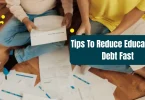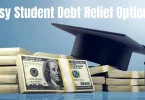If you’re struggling to make ends meet because of student loans, you’re definitely not alone. Many students and graduates across the country face the same challenge — high loan balances, rising interest rates, and uncertainty about how to pay everything back. The good news? There are real solutions available, and they come straight from the federal government.
In this article, we’ll explore everything you need to know about government debt relief help for students, how these programs work, who qualifies, and how you can apply to get the financial relief you deserve. Whether you’re still in school, freshly graduated, or years into repayment, understanding your options could save you thousands of dollars — and a lot of stress.
What Is Government Debt Relief Help for Students?

Government debt relief help for students refers to various programs, policies, and initiatives designed to make it easier for borrowers to manage, reduce, or even eliminate their student loan debt.
These programs are primarily available for federal student loans, such as:
- Direct Subsidized and Unsubsidized Loans
- Direct PLUS Loans
- Direct Consolidation Loans
Private student loans (those from banks or credit unions) usually don’t qualify, but you can still explore other repayment and refinancing options for those.
The main goal of government debt relief programs is to help you:
- Lower your monthly payments,
- Qualify for loan forgiveness, or
- Get complete loan discharge in special situations.
Let’s dive into the major types of government debt relief help for students available in 2025.
1. Income-Driven Repayment (IDR) Plans
If your student loan payments feel like they’re eating up most of your paycheck, an Income-Driven Repayment (IDR) plan might be your best option.
These plans base your monthly payments on your income and family size, not on how much you owe. The goal is to make payments more affordable — sometimes as low as $0 per month if your income is very low.
Types of IDR Plans
- SAVE Plan (Saving on a Valuable Education): The newest and most affordable option, replacing the old REPAYE plan. It cuts monthly payments in half for many borrowers and forgives any remaining balance after 20 or 25 years of payments.
- PAYE Plan (Pay As You Earn): Caps your payments at 10% of your discretionary income, with forgiveness after 20 years.
- IBR Plan (Income-Based Repayment): Also limits payments to 10–15% of your income, depending on when you borrowed.
- ICR Plan (Income-Contingent Repayment): Ideal for Parent PLUS loan borrowers who consolidate — payments are 20% of your discretionary income.
Why It Helps:
After the repayment period (usually 20–25 years), any remaining balance is forgiven. That’s long-term government debt relief help for students in action.
2. Public Service Loan Forgiveness (PSLF)
If you work in public service, you may be eligible for one of the most generous relief options — Public Service Loan Forgiveness (PSLF).
This program is for people working full-time in government or nonprofit organizations, such as:
- Teachers, nurses, and social workers
- Military service members
- Federal, state, or local government employees
- Nonprofit and community organization workers
How PSLF Works:
- Make 120 qualifying payments (about 10 years) while working in an eligible job.
- Enroll in an Income-Driven Repayment plan.
- Have Direct Loans (other federal loans can be consolidated).
- After 120 payments, the rest of your loan is forgiven — tax-free.
This is one of the most life-changing forms of government debt relief help for students, especially for those serving their communities.
3. Teacher Loan Forgiveness

Teachers who dedicate their careers to helping students in low-income schools deserve financial support — and the Teacher Loan Forgiveness Program offers exactly that.
Eligibility Requirements:
- Teach full-time for five consecutive years in a low-income school or educational agency.
- Have Direct or FFEL loans.
- Must be a qualified teacher (certified, and teaching in a high-need area).
How Much You Can Get:
- Up to $17,500 forgiven for math, science, or special education teachers.
- Up to $5,000 for other eligible teachers.
This program is a direct form of government debt relief help for students who go into education — turning years of service into meaningful financial relief.
4. Borrower Defense to Repayment
If your school misled you or violated certain laws, you might qualify for Borrower Defense to Repayment.
This program exists to protect students who were victims of deceptive or fraudulent practices — such as false job placement promises or unaccredited programs.
You May Qualify If:
- Your school misrepresented facts about the quality of education or career outcomes.
- You took out federal loans based on false information.
- Your school violated state laws related to your loan or education.
What You Can Get:
- Full loan forgiveness
- Possible refund of payments made
- Credit repair for any negative marks caused by those loans
This is one of the most powerful and lesser-known forms of government debt relief help for students who were unfairly treated by their institutions.
You may also like to read this:
Easy Student Debt Relief Options: Reduce Your Loans Fast
Best Debt Relief Programs For Students – 2025 Guide
How To Get Student Loan Forgiveness Quickly And Easily
Tips To Reduce Educational Debt Fast – Smart Strategies
Student Debt Consolidation Explained: Complete 2025 Guide
5. Total and Permanent Disability (TPD) Discharge
For borrowers who are permanently disabled and unable to work, the Total and Permanent Disability Discharge provides full forgiveness of federal student loans.
How It Works:
- You must prove your disability through documentation from the VA, SSA, or a physician.
- Once approved, your entire federal student loan balance is wiped out.
- There’s a three-year monitoring period to ensure eligibility continues, but if all requirements are met, your loans remain discharged permanently.
This program ensures that those facing severe medical conditions can access government debt relief help for students without ongoing financial hardship.
6. Temporary Expanded Public Service Loan Forgiveness (TEPSLF)
If you were previously denied for PSLF because your payments didn’t meet the right criteria (wrong repayment plan, for instance), don’t lose hope.
The Temporary Expanded Public Service Loan Forgiveness (TEPSLF) program helps fix that issue by allowing those who made 120 payments under non-qualifying plans to still qualify for forgiveness.
It’s essentially a second chance at getting government debt relief help for students in public service.
How to Apply for Government Debt Relief Help for Students
Applying for these programs might sound complicated, but it’s actually straightforward if you follow the right steps.
Step-by-Step Process:
- Log in to your Federal Student Aid account at studentaid.gov.
- Review your loan types — only federal loans qualify.
- Choose your program (PSLF, IDR, Teacher Forgiveness, etc.).
- Complete the application form online.
- Submit supporting documents like income proof, employment certification, or school information.
- Keep copies of everything for your records.
Important Tips:
- Never pay third-party companies for help — applying is completely free.
- Set reminders to recertify your income annually if you’re on an IDR plan.
- Use the Loan Simulator tool at studentaid.gov to explore which program benefits you most.
Other Relief Options Beyond Federal Programs
If your loans are private or you’re not eligible for federal relief, here are some additional strategies:
- Refinancing: Lower your interest rate and simplify payments (available through private lenders).
- Deferment or Forbearance: Temporary pause on payments if you’re facing financial hardship.
- State-Sponsored Forgiveness Programs: Many states offer loan assistance for healthcare workers, teachers, or lawyers in public service.
These aren’t technically part of government debt relief help for students, but they can still lighten your financial load.
Common Mistakes to Avoid
- Ignoring communication from your loan servicer — stay updated.
- Missing recertification deadlines for income-driven plans.
- Falling for scams that promise “instant forgiveness.”
- Not checking eligibility for multiple programs — sometimes you can qualify for more than one.
Final Thoughts
Student loans can feel overwhelming, but you don’t have to face them alone. The federal government offers multiple programs that provide genuine government debt relief help for students, no matter your income level or career path.
Whether you choose Income-Driven Repayment, Public Service Loan Forgiveness, or another relief option, the most important step is to take action. Don’t let confusion or paperwork stop you — visit studentaid.gov today, learn about your eligibility, and start moving toward a debt-free future.
You’ve already invested in your education; now it’s time to make sure your financial future benefits from that investment, too.
FAQs
1. What exactly is government debt relief help for students?
Government debt relief help for students refers to federal programs designed to reduce, forgive, or eliminate student loan debt. These include options like Income-Driven Repayment plans, Public Service Loan Forgiveness, Teacher Loan Forgiveness, and other discharge programs for specific circumstances such as disability or school misconduct.
2. Who qualifies for government debt relief programs?
Eligibility depends on the specific program. Generally, you must have federal student loans (Direct Loans, FFEL, or Perkins Loans). Some programs also require you to work in public service, teach in a low-income school, or meet income-based criteria. Private student loans usually don’t qualify for government programs.
3. How do I apply for government debt relief help for students?
You can apply through the official Federal Student Aid website at studentaid.gov. Create or log in to your account, check your loan details, and select the program you qualify for. The application process is free — you should never pay a third party to apply for you.
4. What is the difference between loan forgiveness, cancellation, and discharge?
While all three reduce or eliminate your debt, they apply in different situations:
Forgiveness: Typically for borrowers who work in qualifying jobs (like teachers or public service employees).
Cancellation: Often applies to specific careers or service terms.
Discharge: Applies when you can no longer repay due to circumstances like total disability or school closure.
5. How long does it take to get approved for loan forgiveness?
The timeline varies depending on the program. For example:
Public Service Loan Forgiveness (PSLF) takes at least 10 years (120 payments).
Income-Driven Repayment forgiveness takes 20–25 years.
Other programs, like Borrower Defense, may take several months to process after submitting your application.






